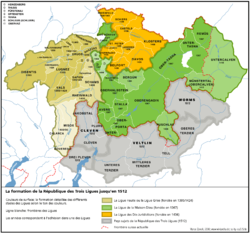League of the Ten Jurisdictions
| League of the Ten Jurisdictions | ||||||||||
|
Zehngerichtenbund (German) Lega delle Dieci Giurisdizioni (Italian) Ligue des Dix-Juridictions (French) |
||||||||||
| Associate of the Old Swiss Confederacy | ||||||||||
|
||||||||||
|
||||||||||
|
The League of the Ten Jurisdictions is shown in orange within the Three Leagues. The Grey League is shown in shades of brown, the League of God's House in green and subject territories, subsequently lost, in grey.
|
||||||||||
| Capital | Davos | |||||||||
| Government | Republic | |||||||||
| Historical era | Middle Ages | |||||||||
| • | League of the Ten Jurisdictions founded | 1436 | ||||||||
| • | Eight Jurisdictions ally with the League of God's House | 1450 | ||||||||
| • | Alliance with the Grey League | 1471 | ||||||||
| • | Bundesbrief constitution for the Three Leagues | September 23, 1524 | ||||||||
| • | All Ten Jurisdictions free from Austria | 1649–1652 | ||||||||
| • | Annexed to the Helvetic Republic | April 21, 1799 | ||||||||
|
||||||||||
The League of the Ten Jurisdictions was the last of the Three Leagues founded during the Middle Ages in what is now Canton Graubünden of Switzerland. The League was created in the County of Toggenburg after the counts of Toggenburg died out. The League initially existed to resist the power of the House of Habsburg, and quickly allied with the Grey League and the League of God's House. In 1524 the three leagues joined together to become the Free State of the Three Leagues, which existed until the Napoleonic dissolution of the Free State.
The League of the Ten Jurisdictions was the last of the three leagues to be founded. On April 30, 1436 the last Count of Toggenburg, Friedrich VII, died without any male heirs and without a will. The Toggenburg lands included the valley of Prättigau, the upper Albula valley (Belfort), Churwalden, Schanfigg and Maienfeld. For the Toggenburg properties, the future was very uncertain. The communities would either be split among other nobles, or the entire County of Toggenburg would be inherited by the House of Habsburg. The leaders of the communities chose a third path, they reached an agreement with Friedrich's widow, Elisabeth von Matsch. In Davos on June 8, 1436 the former Toggenburg lands formed a pact with the support of Elisabeth. Leaders of the communities of Klosters, Davos, Castels, Schiers, St. Peter (part of Schanfigg), Langwies, Churwalden, Belfort, Maienfeld and Malans (which was under the jurisdiction of Neu-Aspermont) met and agreed to protect their rights, to only collectively enter other pacts and treaties, to appoint judges from each community and to re-swear the pact every twelve years. It is significant that there were no nobles involved in creating the pact, instead it was the common people from the communities that swore the pact.
...
Wikipedia



